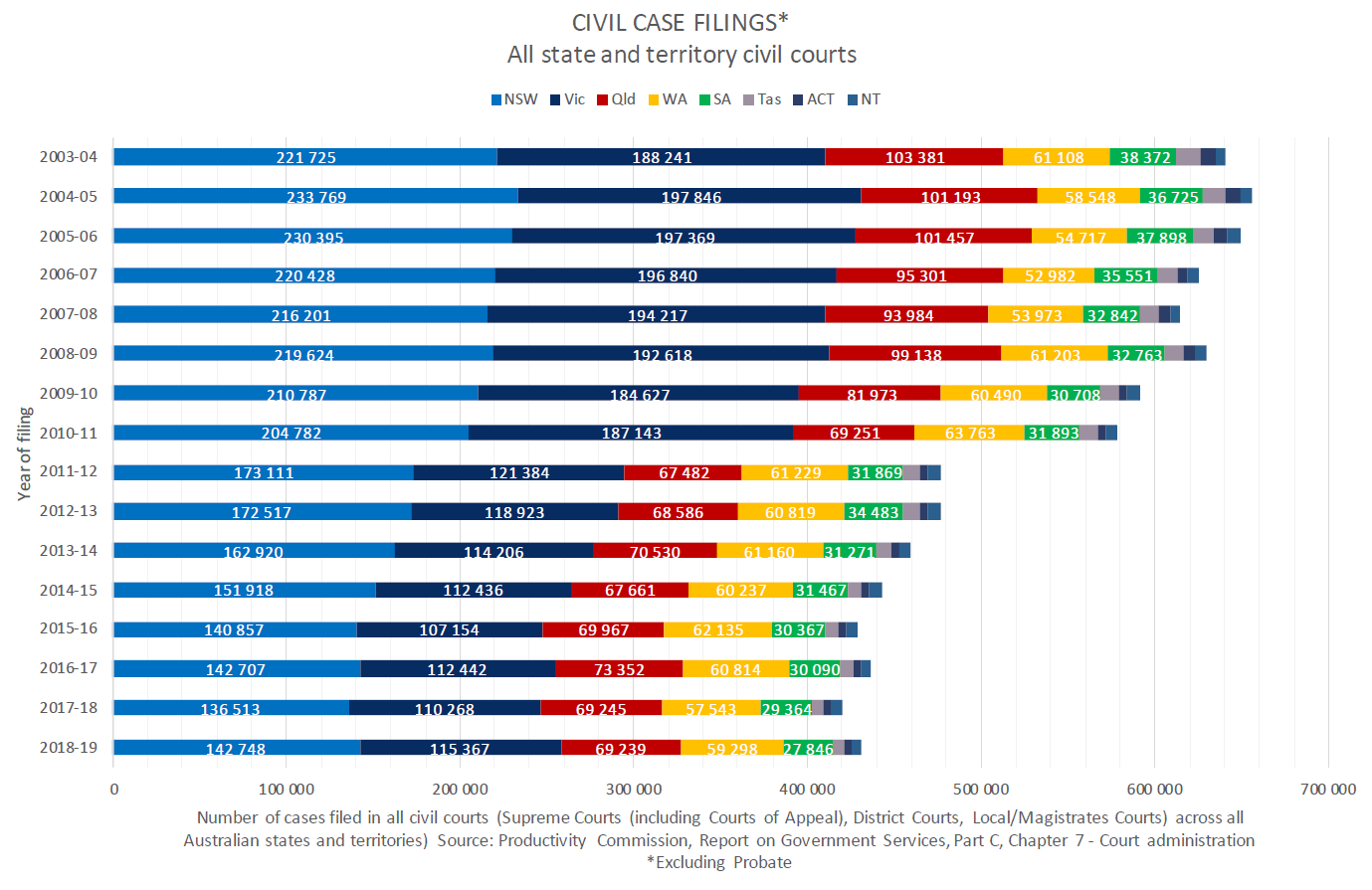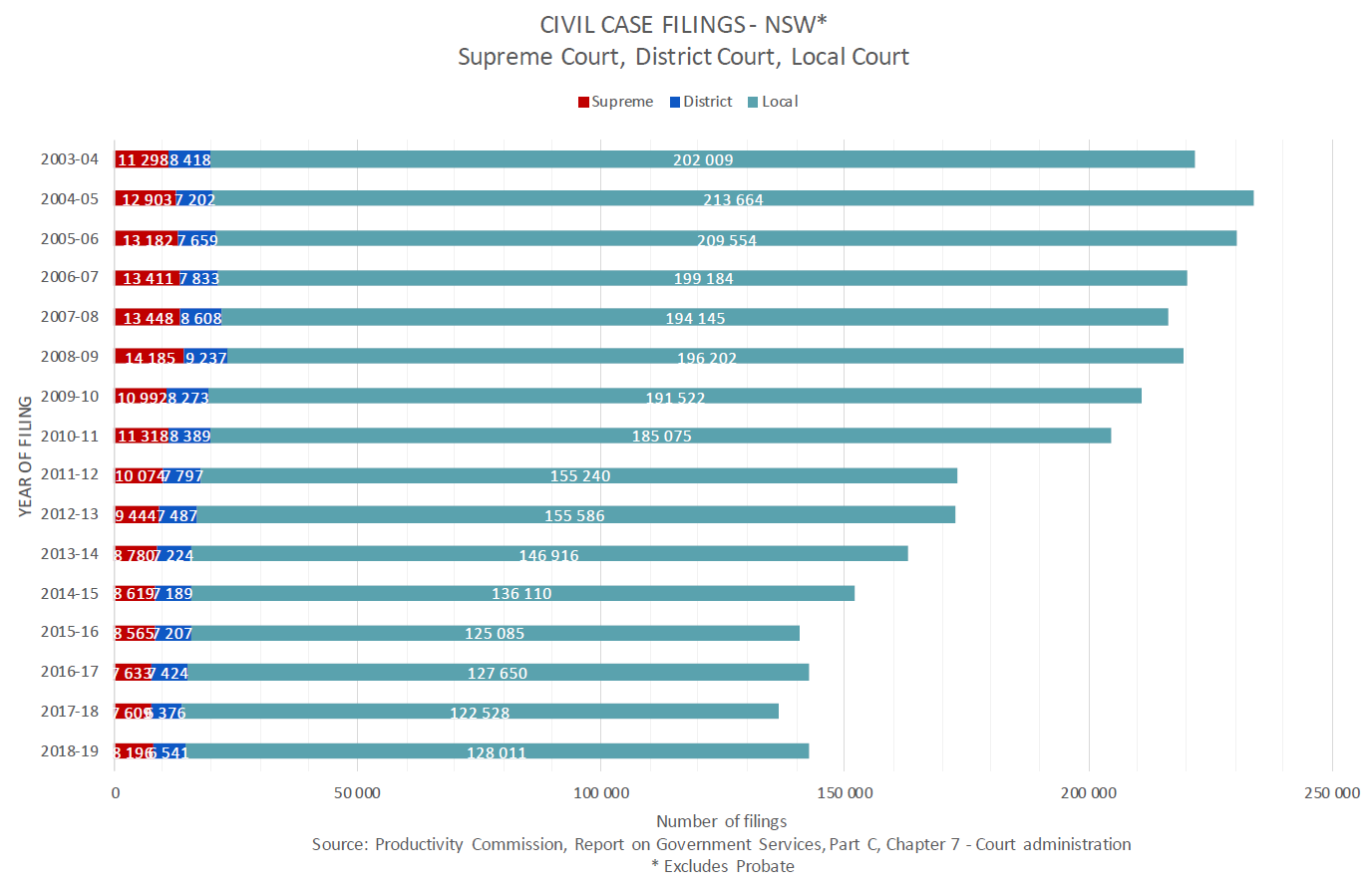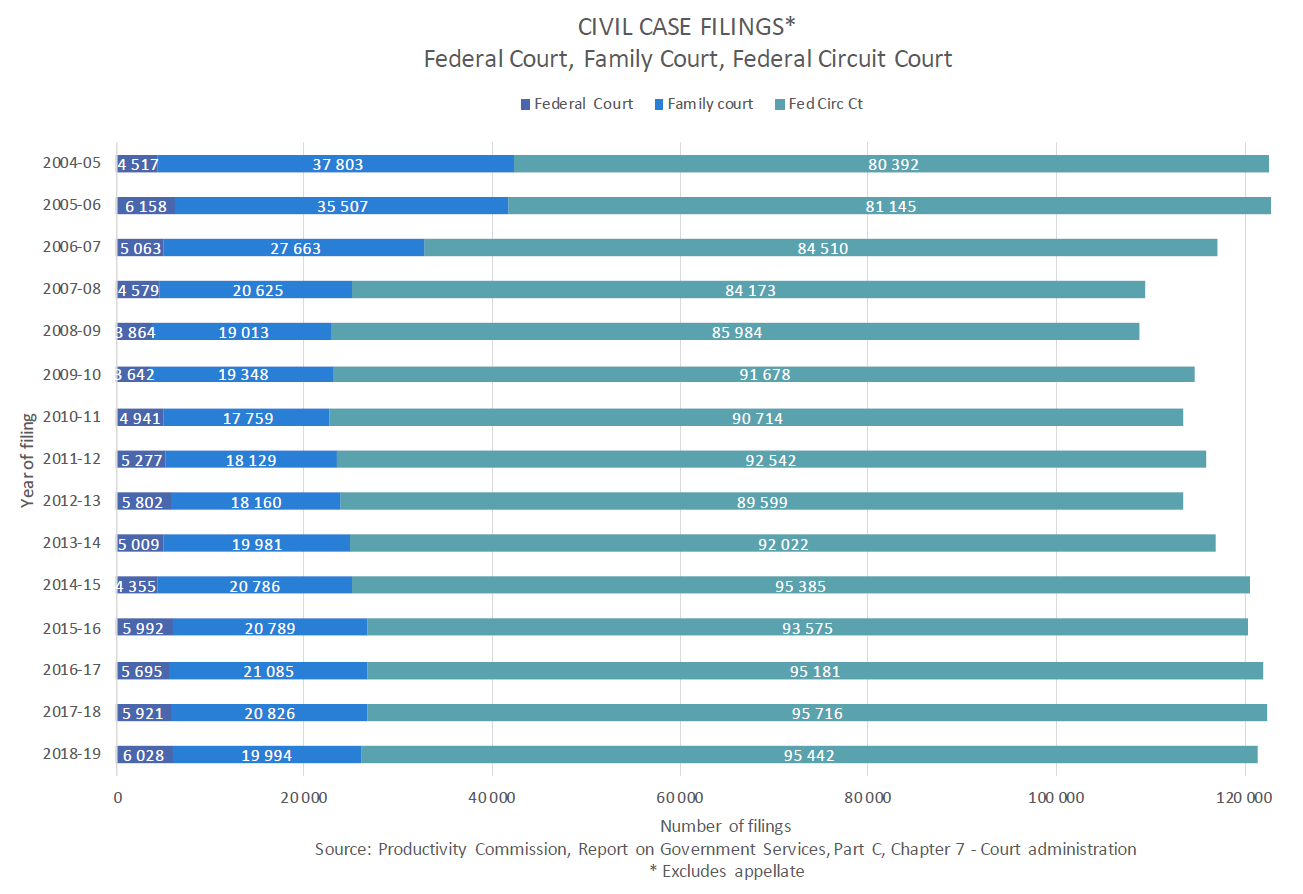After COVID-19: marketing the Bar through and after the pandemic

When Coronavirus Disease 2019 (COVID-19) exploded into our lives in the early months of 2020, none of us could have been prepared for its rupturing impact. While the long-term implications are not yet clear as at the time of writing (being 5 June 2020), life at the Bar is being restored and we have rapidly adapted to a ‘new normal’.
The Bar faced hurdles before COVID-19, some of which will have been exacerbated by the challenges introduced by the pandemic. Those hurdles included falling rates of litigation across the civil courts and the Bar facing the reality of operating in a buyers’ market. These hurdles, if left unaddressed, threaten the continuing strength, success and vitality of the Bar crucial to the continuation of its role in the promotion of access to justice.2 If one considers, for instance, rates of litigation commenced in the civil courts across all Australian states and territories as disclosed in the Productivity Commission ‘Report on Government Services 2020’, it is apparent that civil filings Australia-wide in those courts have trended down by approximately 32.39% between 2003 and 2019 (see table below and Graph 1).
When the same period is considered for the same courts in NSW alone, the figure is closer to 35.62% (being the drop from 221,725 to 142,748 filings per annum: see Graph 2), although if a period only marginally less is considered for NSW alone (2005–2018) the downward trend is closer to 44.84%,3 which is a more accurate portrayal of the trend over the entire period, as is demonstrated in Graph 2 overleaf, given the spike in filings that happened to occur in 2004–2005 and 2018–2019.
While civil filings in the federal courts (excluding the Family Court) have increased during that period, the increase of 18.34%4 (see table below and Graph 3) in either raw numbers or as a percentage does not counteract the drop in litigation in the state courts. When Family Court filings are included, the variance in federal filings over the entire period is less, with in fact a downward dip (see Graph 3). Similarly, while a significant proportion of civil litigation is now dealt with by tribunals,5 in those tribunals representation is often only permitted with leave.6
While it has been observed, in respect of different challenges presenting themselves to Bars in other jurisdictions, that ‘when the pie is no bigger’ it follows that ‘the way that it is sliced up is going to be different’,7 it may well be instead that when the pie is getting smaller the Bar can market itself by promoting the unrivalled benefits that barristers can bring, thereby encouraging use of the Bar across a decreasing market share or ‘pie’. It is not, of course, suggested that promoting the Bar, individual chambers or individual barristers can necessarily increase the underlying size of the ‘pie’;8 however, more than ever, it is incumbent upon Australian Bars to promote
|
Snapshot of civil cases lodged Australia-wide from 2003 to 20199 |
||
|
Selected years over the period 2003–2019* |
Civil cases lodged in the state courts across all Australian states and territories (excl probate) |
Civil cases lodged in the federal courts (excl Family Court, excl all appellate) |
|
2003–2004 |
647,242 |
82,858 |
|
2004–2005 |
660,535 |
84,909 |
|
2008–2009 |
633,231 |
89,848 |
|
2009–2010 |
594,843 |
95,320 |
|
2013–2014 |
464,328 |
97,031 |
|
2017–2018 |
425,684 |
101,637 |
|
2018–2019 |
437,544 |
101,470 |
|
*See Graphs 1-3 overleaf for civil cases lodged in each year throughout this period. |
||
the critical, unique services that those Bars provide to the community and raise awareness as to what would be lost in terms of access to justice should the Bar diminish. It may be that this need is particularly acute in light of the increasing proportion in recent years of litigation dealt with (at least in the early stages) by the online court system, contributing to the contraction of the pool of court work available to the junior Bar. The pandemic-driven wholesale shift to virtual litigation, aspects of which are predicted to stay given the time- and cost-effectiveness of such measures,10 may further increase the need to raise awareness as to the advantages conferred by legal representation, particularly by barristers.
Barristers and chambers promoting and marketing their unique services individually is not new, and has been successfully undertaken in NSW, across Australia and throughout the common law Bars globally for a decade or more. It is established that well-researched and developed branded chambers can be more memorable, recognisable and more readily promoted, that increasing levels of market competition has made presenting and communicating the expertise of barristers and chambers important and that nuancing such communications differently to targeted audiences and stakeholders can
be imperative.11 Maintaining an ongoing dialogue with clients and solicitors, even when not actively engaged in matters together, by hosting interactive and relevant chambers websites, disseminating short articles including via industry journals about recent cases of the chambers’ members, posting recent development updates on platforms such as LinkedIn and Twitter and issuing regular newsletters are tried and true techniques for staying front of mind.12 Of course, doing a good job is always first on the list.13
Indeed, so accepted is the notion in the United Kingdom of barristers’ chambers promoting their services that the UK Bar Standards Board Handbook provides an example of this occurring whereby ‘members of a chambers establish, own and manage a limited company in order to advertise and market their services more effectively’ using that company to do so (and to do only that),14 although it is not suggested that such a method is readily transposable to the NSW Bar. Not dissimilarly, the American Bar Association includes on its webpage articles describing the benefits and costs-savings for lawyers of enlisting chatbots to both carry out online marketing (by the use of automated responses to queries) and to analyse consumer data,15 as well as general ‘how-to’ articles on promotion through social media16 and tips and data on affordable website content and internet marketing strategies for sole practitioners as well as firms.17 Each of the UK Bar Standards Board, the UK Bar Council and the American Bar Association include, as well, content on the rules and ethical obligations surrounding such promotional conduct,18 with some not dissimilar rules enshrined in the NSW professional conduct rules.19
Many of these techniques undoubtedly remain important through the global impact of a pandemic. However, it may be that the current circumstances also require something more. It may be that a unified, holistic promotion of the benefits of the services provided by the Bar as a whole is, more than ever, necessary; an approach that promotes and markets the responsiveness and timeliness of services that barristers provide, and the cost- and time-efficiencies of engaging barristers and engaging them early. So much is recognised by rightly describing barristers as the ‘original, flexible, on-demand legal advisors for individuals, organisations, corporations and government agencies’.20 It may also be that such a unified promotion of the Bar extends beyond NSW, with audiences further afield targeted, and that such promotion encompasses the substantial commercial value-add that barristers provide to businesses.21
Such a holistic approach dovetails with and is envisaged by the NSW Bar Association Strategic Plan,22 which includes ‘marketing and promoting the work of barristers’ and ‘promotion of the Bar as a highly cost efficient part of the litigation process’. Similarly, the 2020–2025 Strategic Plan of the Australian Bar Association includes ‘promot[ing] the Bar’s high quality specialist advocacy and advisory services’ and ‘[d]evelopment and promotion of business opportunities for Australian barristers in Australia and internationally’. Some of these holistic promotional steps by the NSW Bar Association and the Australian Bar Association have been underway for some time, with the then Australian Bar Association President quoted in 2017 (in respect of direct briefing) as saying that it was ‘in everyone's best interests – including the courts – to have barristers briefed more effectively and earlier in litigation’, commenting on the consequent positive outcomes of doing this, including early clarification of the issues and an overall reduction in legal fees.23 Commensurate with these promotional steps, in January 2020 the NSW Bar Association appointed a Director of Projects and Practice Development, an aim of which is to facilitate marketing the Bar.
Correspondingly, one of the Victorian Bar’s primary objectives in its 2020–2024 Strategic Plan is to ‘maintain and expand market share’ by ‘rais[ing] awareness of barristers’ competencies among clients and the community’ and enabling ‘members to contribute to the Bar’s marketing’. Such promotion in no way needs to cut across the services provided by solicitors, nor indeed their market share, but rather complements those services, as was recognised by former President of the Australian Bar Association, Fiona McLeod SC, in connection with the promotion then of direct briefing. 24
One can be informed as to the likely impact of COVID-19 on the ability of the Bar to resiliently survive and thrive during and after the pandemic, including by promoting itself so as to remain strong and responsive, by looking to the responses of Bars and the legal profession generally to other disruptions of the past century: the 1918 influenza pandemic, the 1929 depression and the 2008 global financial crisis (GFC) are informative. Perhaps even the other modern history virus pandemics of 1957, 1968 and 2009 are also instructive.25 It has been observed in respect of the GFC for instance that, while in the short term ‘the impact of the economic meltdown on the legal profession has been quite devastating: unprecedented layoffs, salary decreases, hiring freezes…’,26 a ‘wave of litigation’27 followed.
Similarly, a ‘rush of coronavirus-related disputes’ has been predicted in the short to medium term in the current environment, based on lessons from the GFC.28 Not long after the GFC, in 2010, it was said that ‘…it is important to bear in mind that points of significant distress are at the same time moments of great opportunity, and the legal profession, with its track record of adapting to changing practice realities … may end up stronger than ever’.29 It has even been said that the ‘huge revolutions’ following the GFC made it an ‘electrifying time to be in the legal profession.’30
After the Great Depression, differing segments of the US legal profession responded in different ways to the economic collapse, from which it is said lessons can be learned about the likely non-homogenous yet resilient response of the legal profession to economic downturns and ‘the complex ways in which severe economic stress impacts the profession in the long run.’31 That being said, there is no reason to assume that an overarching unified response with a common aim of promoting the Bar through the downturn would not be appropriate.
As an example of such resilience, it is noteworthy that in 2009, the then American Bar Association President said that ‘[s]ince our founding in 1878, the American Bar Association has … survived the Great Depression, overcome two World Wars, and experienced countless ups and downs along the way to become the single largest voluntary professional organisation in the world’, going on to observe that ‘[w]e must ensure that our efforts to advocate for our profession – as well as our work to strengthen the rule of law and expand access to justice in our country – are heard…’32
Finally, research has shown that an increase in market share (for companies such as Kellogg, Chrysler and Hyundai for instance) resulted from marketing through and after the Great Depression and GFC, even as the economy cratered, although it is equally to be observed that there are many other entities that ‘gambled and failed’.33 It may also be that litigation and legal representation are viewed as an expendable or at least postponable consumable by the community and that appropriate steps can be taken to respond to that,34 including examining ways of making such representation more affordable (such as by making chambers accommodation more cost-effective, particularly for the junior Bar), given at its core what is at stake is access to justice. While there is no suggestion that the Bar, barristers or chambers are or ought to be considered analogous with corporate entities, it may be that lessons can be drawn from such experiences. There is also no suggestion that any steps taken need be costly.
Given the Bar and the ‘private profession [generally] plays a critical part in ensuring access to justice’,35 which is ‘intertwined with the rule of law’,36 it is crucial that the pivotal contributions and advantages bestowed by the Bar are now as much as ever lauded.
The author would like to thank the NSW Bar Association Library for its invaluable research assistance in the preparation of this article.
Graph 1: CIVIL CASE FILINGS*
All state and territory civil courts

Graph 2: CIVIL CASE FILINGS – NSW ONLY
Supreme Court* (inc Court of Appeal), District Court, Local Court

Graph 3: CIVIL CASE FILINGS*
Federal Court, Family Court, Federal Circuit Court

ENDNOTES
1 The author would like to thank Richard Cheney SC, Anthony Cheshire SC, Farid Assaf SC and Tobias O’Hehir of Lander & Rogers for their invaluable insights in the preparation of this article.
2 The legal profession’s ‘critical part in ensuring access to justice’ was highlighted in the Law Council of Australia’s The Justice Project: Final Report – Introduction and Overview, August 2018, p38.
3 The period of 2005–2018 was considered for NSW court filings in ‘Are there implications of NSW court filing trends?’ [2019] (Summer) Bar News 34, with a decrease during this period of 44.84%, based on data from NSW court annual reports/reviews which compile filing data per calendar year. The Productivity Commission data herein is compiled by financial year, accounting for slight variances.
4 The shorter period of 2009 to 2019 was considered for federal filings in ‘Are there implications of NSW court filing trends?’ [2019] (Summer) Bar News 34, with an increase of 13.1% given the analysis included appellate filings. The current analysis based on Productivity Commission data excludes federal appellate filings.
5 E.g., NCAT received 71,449 claims in 2014–2015; 69,456 claims in 2015–2016; 66,837 claims in 2016–2017; 65,549 claims in 2017–2018; and 68,388 claims in 2018–2019 (see the NCAT Annual Reports for these periods).
6 Eg, s 45(1), Civil and Administrative Tribunal Act 2013 (NSW); s 62, Victorian Civil and Administrative Tribunal Act 1998; s 43, Queensland Civil and Administrative Act 2009.
7 New Zealand Bar Association, ‘Marketing yourself as a barrister’, 2012.
8 With the ‘pie’ referred to as being the amount of litigation commenced in Australian courts, although it is recognised that Australian barristers appear also in overseas jurisdictions and perform non-litigation based work.
9 A consideration of the reasons for the general downward trend in civil court filings in the state and territory courts is outside the scope of this article, however several of the court annual reports and annual reviews provide short reasons for some of these drops: see for instance 2009 Local Court of New South Wales Annual Review, p25-27 (‘Developments in 2009’).
10 Pelly, ‘Chief Justice predicts more 'effective' courts, cheaper justice,’ Financial Review, 8 May 2020.
11 Davis, ‘Marketing the Bar’, barristermagazine.com, 2013; ‘Barristers: Develop and Promote your Personal Brand’, Legal Insight, Thomson Reuters, June 2015.
12 Tasso, ‘Barrister marketing: what is the best way for barristers to market themselves?’ kimtasso.com, 2011.
13 New Zealand Bar Association, ‘Marketing yourself as a barrister’, 2012.
14 UK Bar Standards Board Handbook, Referral and Marketing Arrangements Guidance, October 2019, p4.
15 Martin ‘Marketing Automation for Lawyers’, Americanbar.org, April 2019.
16 Hu, ‘Effectively using social media with hashtags’, Americanbar.org, April 2019.
17 Shields, ‘2018 Marketing’, Americanbar.org, January 2019; Shields, ‘2019 Websites and Marketing’ Americanbar.org, October 2019.
18 E.g. ‘Ethics & Practice: Advertising and website profiles’, Barcouncilethics.co.uk, 18 November 2019; UK Bar Standards Board Handbook, Referral and Marketing Arrangements Guidance, October 2019, p1-6; ‘Rule 7.2: Communications Concerning a Lawyer's Services: Specific Rules’, Americanbar.org.
19 E.g. Legal Profession Uniform Law (NSW), s 11; Legal Profession Uniform Conduct (Barristers) Rules 2015, Rule 76-77; more comprehensively see Dal Pont, Lawyers’ Professional Responsibility, 6th ed, LBC, 2017, [20.05]-[20.70]; also Millist-Spendlove ‘Websites, social media and a barrister’s practice’ [2013] (Summer) Bar News 49.
20 www.vicbar.com.au/public/how-barrister-can-help.
21 This being done is seen in Gaffney, ‘Adding value to client relationships’, Lawpracticetoday.org, 13 October 2016.
22 For 2017–2020, with the 2020–2025 Strategic Plan currently being finalised.
23 Walsh, ‘Centuries-old profession modernising as barristers tout for company business’, Financial Review, 10 August 2017.
24 Ibid.
25 During which 1.1 million, 1 million and up to 575,000 people died respectively: www.cdc.gov/flu/pandemic-resources/1957-1958-pandemic; www.cdc.gov/flu/pandemic-resources/1968-pandemic; www.cdc.gov/flu/pandemic-resources/2009-h1n1-pandemic.
26 Wald ‘Foreword: The Great Recession and the Legal Profession’, (2010) 78(5) Fordham Law Review 2051.
27 Mazumdar and Caswell, ‘The Global Financial Crisis and Reinterpreting Lessons from History’, Americanbar.org, February 2015.
28 Rothwell, ‘2008 crash offers glimpse of our future’, UK Law Society Gazette, May 2020.
29 Wald, op cit at 2052.
30 Martha L Minow, Dean of Harvard Law School cited in Wald, ibid at 2051.
31 Ibid at 2053-4.
32 Lamm, ‘Now more than ever’ (2009) ABA Journal 9.
33 Surowiecki, ‘Hanging Tough’, The New Yorker, 20 April 2009.
34 E.g. Quelch and Josz, ‘How to market in a downturn’ Harvard Business Review April 2009.
35 Law Council of Australia, The Justice Project: Final Report – Introduction and Overview, August 2018, p38; Pt2, p4; Pt2, p11.
36 Ibid, Overarching Themes, p64.